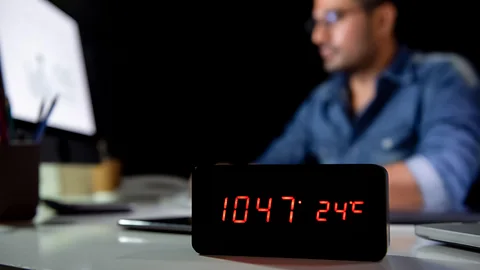The 'chronoworking' productivity hack that helps workers excel
 Alamy
AlamyThe key to getting the most out of workers may be allowing them to do their jobs when they feel like it.
Most days, Eloise Skinner is still working at midnight. The writer, fitness instructor and therapist opens her computer to check email around 11:00, takes the afternoon or early evening shift at the London gym where she runs workout classes, then sits down to tackle in-depth projects after 19:30. By that time, "the world has gone quiet", she says, and she feels best able to concentrate.
The 32-year-old self-proclaimed "night owl" has been planning work around her biology for years, even across different jobs and time zones. "It sounds a bit extreme, but it just is a reflection of the fact that I really, really focus around 8, 9 or 10pm," says Skinner. "That's when I'm at my most productive."
Amid a growing desire for flexible work post-Covid-19, workers are increasingly interested in the kind of set-up Skinner has, with many pushing their companies to adapt their working hours to natural energy levels for maximum productivity. The approach is called "chronoworking".
Originally coined by journalist Ellen C Scott, chronoworking enables employees to ditch standard office hours and pick schedules that match their personal "chronotypes" instead – the natural time at which their bodies want to sleep.
There are four chronotypes, according to American clinical psychologist and "sleep doctor" Michael Breus. According to his surveys, 55% of people find peak productivity in the middle of the day (10:00 to 14:00); 15% are best suited to early-morning starts; 15% are better working late into the night; and 10% have a more erratic circadian rhythm, which can vary from day to day.
Despite these variations, however, the traditional 9-to-5, eight-hour workday – invented by US labour unions in the 1800s – is still the norm. As a result, many people must work outside their preferred hours of peak productivity; in one small January survey of nearly 1,500 American workers, 94% of respondents said this was the case, and 77% said mandated standard working hours impacted their job performance. To cope, nearly half take said they naps during the workday; 42% load up on caffeine to maintain energy levels; and 43% use stress-management techniques, like mindfulness.
 Alamy
AlamyChronoworking isn't new, yet it has attracted more attention since the pandemic, as remote and hybrid work has mainstreamed, says Dirk Buyens, professor of HR management at Vlerick Business School in Brussels. "No longer do we all spend an hour or so on a commute between the set times of around seven to nine in the morning, and we can truly understand when we are most productive and how to get the most out of our job."
Workers, especially younger ones, like the idea of suiting their schedules to their most productive hours – but companies also stand to benefit from chronoworking, adds Buyens. Allowing staff to work when they're at their best could boost performance and wellbeing, with a knock-on positive effect on employee retention. "If workers are happy and that their managers allow them to work hours that suit their needs, they are going to be more likely to stay at the organisation," he says.
It's not a widespread phenomenon. Many companies still find it unconventional; and it simply can't work for others, like customer-facing businesses or those tied to outside factors, like stock market hours. Yet some firms without these constraints – often with globally distributed workforces – are introducing it.
None of the 17 employees at London-based jobs platform Flexa follow the same working pattern. Instead, says CEO Molly Johnson-Jones, they're free to construct their days based on when they feel most productive. Some start as early as 07:30, while others don't log on until 11:00, and work later into the evening.
It's the right fit for the remote organisation, she says. "It's nonsensical that we all need to be working together all at one time. You get far more out of people if you operate around different chronotypes." The approach has the added benefit of normalising flexible hours for parents or those with other responsibilities that make it tricky to stick to 9-to-5 restrictions, she adds. "It levels the playing field."
Chronoworking could create practical challenges, though, warns Buyens. As much as the approach grants workers independence and the ability to have a non-linear workday, team members still need at least some "crossover hours" for meetings and shared projects. They also need to be aware of each person's individual working hours. Managers may struggle, both with overseeing staff output and also making sure they are available and supportive leaders at all times, he adds.
Yet for some of the companies adopting chronoworking, there are ways around these issues. For instance, Flexa requires all its staff to be online during the core hours of 11:00 to 15:00. This allows the team to "blitz through" shared tasks. Other companies use software to record meetings and share with those team members who didn't join, helping bridge the gap of asynchronous work.
The benefits far outweigh the challenges, believes Johnson-Jones. "We'll get more out of people and people will be more productive if they can operate around their own chronotypes," she says. "Some people are morning people, some prefer the evening and some are bang in the middle. We're all different, and so we can't be expected to thrive in the same environment."
